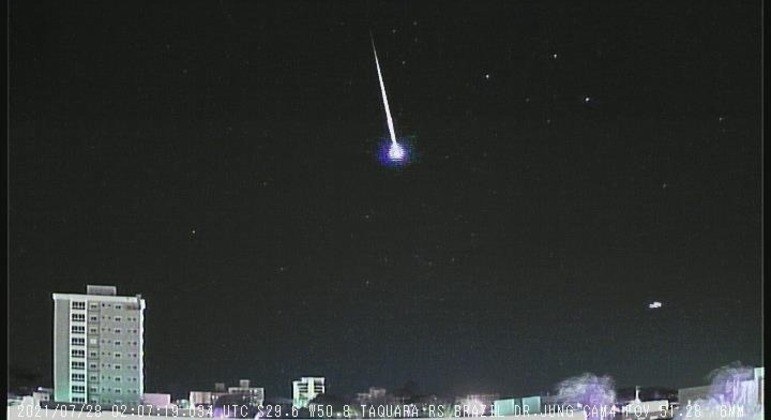The Alpha Capricorniids meteor shower can be observed until the first days of August throughout Brazil. Just like the Delta Aquariidis, there is no peak day and, for several days, it is possible to see up to five meteors per hour. The particularity of the phenomenon is that the light trails in the sky are accompanied by small explosions, which makes the observation much more interesting.
According to the technical director of Bramon (Rede Brasileira de Meteoros), Marcelo Zurita, Alpha Capricorniids is caused by the fragments left in space by comet 169P/NEAT, discovered in 2002. of the Sun are denser compared to other comets, which would explain the formation of explosive meteors.
“In the case of Delta Aquaridiis, as well as most meteor showers, the observer can see a light streak in the sky with an almost constant glow. In the case of Alpha Capricorniids, the view is of a light streak followed by a sudden moment of shine,” he says.
The photo below shows an explosive meteor from Alpha Capricorniids that crossed the sky over Taquara, Rio Grande do Sul, in the early morning hours of the 28th to the 29th of July. The record was made by astronomer Carlos Jung, from the Heller&Jung Observatory and a Bramon collaborator.
Eventually, some fireballs will appear in the sky, that is, meteors that have more luminosity than the planet Venus and that end with an explosion, according to the definition of the International Meteor Organization.
Zurita points out that, despite Alpha Capricorniids being a low-intensity rain, Bramon has registered an atypical activity since the beginning of the month. One of the network’s collaborators even identified 80 meteors of this type in a single night, which would indicate that it was not related to rain. Some people might then catch a few sporadic meteors crossing the sky.
How to observe?
The best time to watch will be between midnight and midnight and a half, when the Capricorn Constellation is already high in the sky and the Moon has not yet risen. Currently, Earth’s natural satellite is at 75% of its apparent brightness, which blurs the view somewhat.
“To contemplate the phenomenon, simply move to a place far from the city lights, such as a farm or farm, and lean back in order to have the largest field of vision possible. Even though the radiant rain is the star Alpha Capricorni, in the Capricorn Constellation — which means that all meteors seem to originate from this point, in the eyes of the observer — the orientation is to look at the sky in all directions,” he says.
Alpha Capricorniids or sporadic meteor?
According to Zurita, to identify whether the meteor seen is an Alpha Capricorniids or a sporadic meteor, it is enough to refer to the planet Jupiter — which, this year, coincidentally, is close in the sky of the star Alpha Capricorni.
A tip for locating the planet in the sky is to use astronomical sky simulation apps, in which the cell phone camera identifies planets and constellations in the sky. Another, simpler alternative is to look for the brightest celestial body in the sky.
Once that’s done, the next step is to imagine a line in the sky starting from that specific point. If the meteor crosses this line, it is a star from the Alpha Capricorniids. Otherwise it’s a sporadic meteor.
*Intern of the R7 under the supervision of Pablo Marques
– .


